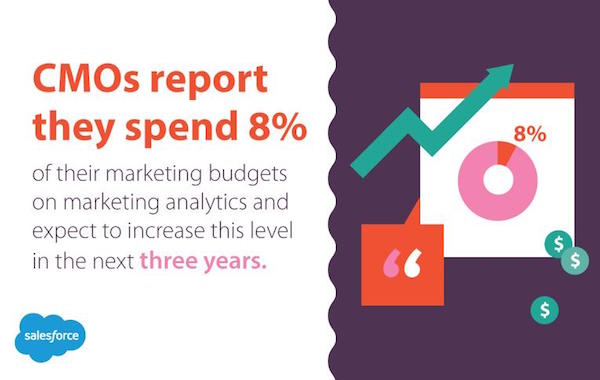
Get your FREE 30-day trial.
Please complete all fields.
A successful marketing process identifies viable marketing opportunities, and then helps to develop a strategy for taking advantage of those opportunities to connect with customers and increase profits. However, not all marketing processes are effective. To ensure your marketing plan is worth the resources you’re putting into it, you need to be able to evaluate it with an objective eye, and improve it where necessary.
According to a report by Carat, marketers around the world are expected to spend a total of 540 billion dollars on advertising over the course of 2015. There’s no denying that marketing is a key focus of businesses both large and small. However, with all of this money being invested in the hopes of capturing public attention, marketing teams are finding themselves under growing pressure to deliver tangible and undeniable results. In essence, it is no longer enough for marketing professionals to simply get prospective customers interested in a product; instead, marketers are now directly responsible for identifying a large number of high-quality leads, and then inserting those leads directly into the sales funnel at the most appropriate point so that sales teams can turn those leads into revenue.
The marketing process
Marketing is closely monitored and under constant refinement, as organizations do everything in their power to maximize their impact while trimming ineffective practices. This is a necessary part of marketing and advertising, without which businesses would find themselves unable to grow or improve. Unfortunately, it also means that business leaders need to regularly reevaluate their entire marketing process, and be willing to make sweeping changes when necessary.
In order to establish—or reestablish—a viable marketing process, business leaders need to identify marketing opportunities, devise strategies that allow them to effectively take advantage of those opportunities, oversee the implementation of their strategies, and then finally evaluate the overall effectiveness. These steps are ongoing, and require a constant focus on the consumer in order to gauge impact and performance. Let’s take a brief look at each of them:
1. Identifying marketing opportunities This first step is one that many businesses don’t totally understand. They believe that just because they have an interesting idea, for example, they are ready to build off of that idea and create a working strategy. The problem is that an idea is not an opportunity. Ideas are more nebulous and unrefined, and exist to provide a business with a possible general direction in which to move. Opportunities, on the other hand, are built out of careful observation and an understanding of key metrics. Opportunities are absolutely necessary, as they are often the catalyst that gets everything started. Ideas provide drive and vision, but they are not suitable replacements for opportunities. While different businesses use different methods of identifying opportunities, these methods can generally be sorted into one of two categories—active methods and passive ones.
Active methods are approaches that require action on your part. The gathering of analytical data through keyword research, customer surveys, studies, etc., can all help your organization find potential opportunities that might otherwise go unnoticed. Passive methods can be defined as “watching and listening.” Listening to customer suggestions—and especially complaints—can help you identify new opportunities. Unfortunately, for every customer who takes the time to complain about a product or service, approximately 26 will remain silent, so don’t miss your opportunity to benefit from those complaints when you receive them. Imitating other businesses that seem to have found a great opportunity—but that could stand to improve their execution—are also valuable sources of opportunity (remember, Google wasn’t the first internet search engine, but it was the search engine that was best received).

2. Devising strategies With opportunities clearly identified, your next step should be to develop a strategy. Your strategy should provide you with clear guidelines to follow, so that you can communicate the advantages of your product or service to your target market in a logical and data-focused way. Of course, every strategy will be entirely unique to your business’ situation, but the key focus of your strategy should be to align your marketing efforts with the opportunities that you identified before. Do this by addressing and fulfilling customer needs. Take what you know about the preferences of your target consumer, and highlight corresponding strengths in your product.
Do your customers want something that is easy to use? If so, focus your marketing efforts on showcasing just how user-friendly your product is. If your customers want something that is durable, then concentrate on showing them your product’s durability. Use demographic data to determine the best media for reaching your customers. For B2B marketers, event marketing may be the most effective (67% of B2B content marketers believe that it is), while social media marketing or email marketing may be better suited for other audiences. Whether you’re focused on B2C or B2B lead generation, or some combination of the two, the only way that you’re going to be able to reach your customers is by bringing your marketing to them.
3. Overseeing implementation Once you’ve drafted a detailed strategy, your next objective should be to ensure that it is implemented effectively. There is no simple way to do this, other than to remain vigilant and to continue to pay very close attention to customer responses.
An effective strategy is one that outlines the necessary steps a business should be taking to get the public interested in the product, but still allows for some amount of freedom in how those steps are carried out. If a strategy is proving ineffective, or is being negatively received, then the strategy itself should be immediately re-addressed.
There is no value in sticking with an ineffective strategy, so be ready to alter or completely replace it should it fail to perform as expected. An effective execution of a marketing plan generally requires involvement from teams across an entire organization, so work on improving your internal communication, so that your employees can collaborate together without difficulty.
4. Evaluating results With your strategy fully implemented, all that is left is for you to honestly evaluate the results. The first step in this process is one that that you should have included all the way back in strategy development phase, by planning ahead and building a response-attribution infrastructure into your various marketing channels. This will allow you to determine with a very narrow margin of error which of your efforts are succeeding and which are not.
Analytical data gathered from other sources can be equally valuable. CMOs report they spend 8% of their marketing budgets on marketing analytics, and expect to increase this level in the next three years. Of course, any data that you gather will be completely useless unless you can determine which metrics are most relevant and worthy of measurement.

Some of these will be obvious measurements of success, such as business growth or return on investments (ROI), but others may not be quite as obvious. For content marketing, things such as page visits and bounce-rates may not easily translate into a dollar amount, but can still give you an accurate idea of what aspects of your strategy are and are not effective. This information will help you constantly refine and improve your overall marketing process.
What really matters: The customer
Your marketing process should always focus first and foremost on the needs, wants, and interests of the customer. Marketers who make their own assumptions about customer preferences, or who attempt to redirect customer interests, run the risk of alienating the very people on whom they depend. 85% of CMOs agree that the most important part of the marketing strategy is the customer journey.
Your marketing strategy should be one that reflects the climate of you customer base, and helps the customer progress along that journey; if it isn’t, then it won’t be effective.
In a constantly changing market, effective lead generation and customer retention can mean the difference between success and failure in any business. However, by taking the time to establish, review, and re-establish marketing strategies based upon reliable data and customer feedback, your business will be able to quickly adapt its marketing process to take advantage of any new directions that your target audience might take.
The dawn of the digital marketer is here. Learn how you can stay ahead of the game by downloading the free Salesforce e-book.